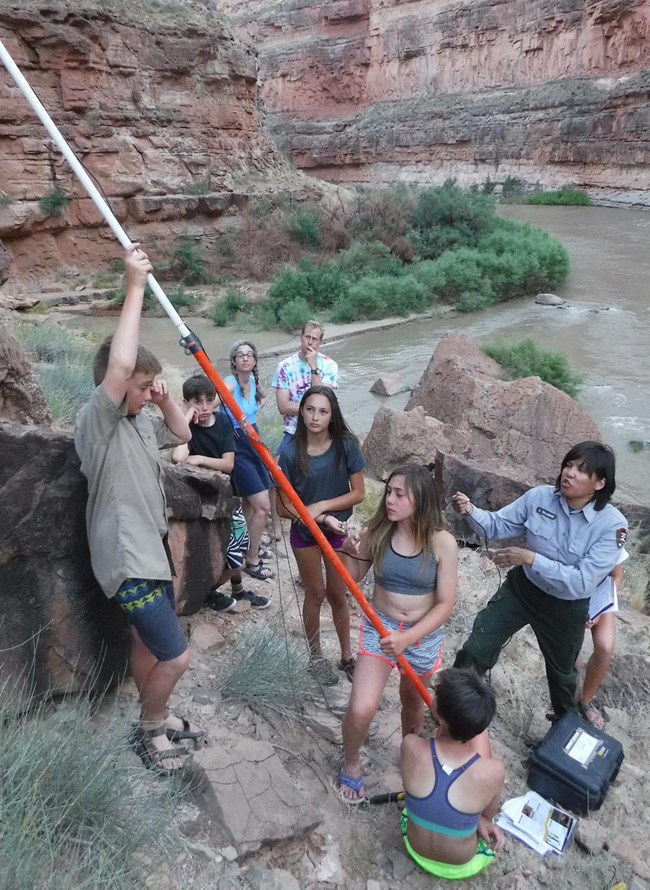Last updated: October 16, 2017
Article
Bat Projects in Parks: Glen Canyon National Recreation Area
Summary
Glen Canyon (GLCA) used the funding to complete the first comprehensive survey of bats within the park. GLCA adopted and surveyed 10, NABat 10- by 10-km (100-km2) grid cell sample units and implemented stationary point and mobile acoustic transect surveys. Mist-netting efforts were incorporated to ease interpretation of acoustic data and to verify species presence in the area. Sampling was targeted in the following vegetation communities: pinyon-juniper woodlands, riparian, and desert shrub. WA SM4BAT FS acoustic monitoring devices recorded 18,632 bat calls and Sonobat 4 identified the following 16 species: P. hesperus, T. brasilensis, A. pallidus, M. californicus, L. noctivagans, M. lucifugus (under investigation), E. fuscus, M. yumanensis, E. perotis, M. thysanodes, L. blossevillii, L. cinereus, E. maculatum, M. volans, M. ciliolabrum, and M. evotis. Acoustic monitoring resulted in two new records for the park: M. lucifugus and E. perotis. The validity of these records is currently under investigation. Mist-netting operations conducted over 14 nights resulted in 136 captures of the following 11 species: A. pallidus, E. fuscus, I. phyllotis, L. noctivagans, M. californicus, M. ciliolabrum, M. thysanodes, M. volans, M. yumanensis, P. hesperus, and T. brasilensis. The L. noctivagans captures (7) occurred in pinyon-juniper woodlands and are new records for the park. On 08/04/16 GLCA and the Glen Canyon Natural History Association hosted the 1st Annual GLCA Bat Festival and welcomed 170 visitors to the event. Attendees enjoyed two presentations focused on bat conservation, threats, and park research. Educational booths and games consisted of WNS and threats, bat house construction, gardening for bats, and arts and crafts for kids. Attendees closed out the evening by learning how to use WA Echo Meter Touch monitoring devices and ventured down to Lake Powell for a bat listening walk. Thank you to Amy Hammesfahr (DETO) and Rene Ohms (DETO) for helping GLCA plan the Bat Festival. GLCA is currently using data collected through this project to develop two manuscripts for publication. All acoustic recordings have been entered into the NPS Bats Acoustic Survey Database and will be uploaded into the NABat Bat Population Database. These data collections are contributing to a statistically robust data set which researchers will use to make inferences about changes in bat species distribution and abundance on local, regional, and continent-wide scales. This research project enabled the park and public to learn a great deal about the distribution and abundance of bat species most susceptible to WNS.

NPS Photo.
Citizen-Based Acoustic Bat Monitoring Along the San Juan River
Methods
- Bat data was collected for 11 nights from May 13, 2016 to June 26, 2016 during Grand Canyon Youth (GCY) river trips along the San Juan River by park biologists and attendant youth.
- Each night biologists and youth would set up a Wildlife Acoustics
- (WA) SMX-U1 microphone connected to a WA SM2BAT+ recording device at a suitable site. The device was set to record bat echolocation calls from sunset to sunrise.
- Collected data was processed through Sonobat 4 software. The software analyzed and classified recorded bat calls to species level.
- To educate the youth, while setting up the WA SM2BAT+ unit, biologists would give a presentation on the importance of bats and their conservation. Biologists would also use WA Echo Meter Touch software/hardware to allow youth to collect and process bat calls in real time. This allowed the youth a direct look at what their work with the WA SM2BAT+ was helping us achieve.

NPS Photo
Conclusion
- A total of 11 unique species were identified using Sonobat 4 software. Of these 11 species, 2 had not been detected at GLCA before: spotted bat and greater mastiff bat. Since Sonobat 4 does not yet possess the ability to analyze Allen’s big-eared and big free-tailed bat calls, we cannot determine if we have calls from either species. We have captured Allen’s big-eared bats through past mist-netting efforts.
- The most abundant bat (acoustically) is the canyon bat, while the least is the silver-haired bat.
- Sonobat 4 classified 27 calls from the little brown bat, but the validity of these calls is currently under investigation. This species does not typically occur within GLCA boundaries, and is highly susceptible to WNS.
Acknowledgements
- We would like to thank No Barriers Youth, Sinagua Middle School, Kanab High School, and Middle School Adventure participants for their assistance in making this project a success.
- We would like to thank all biologists at GLCA who accompanied the youth on the San Juan River trips: Mike Berg, Shandiin Tallman, and Alexis Levorse.
